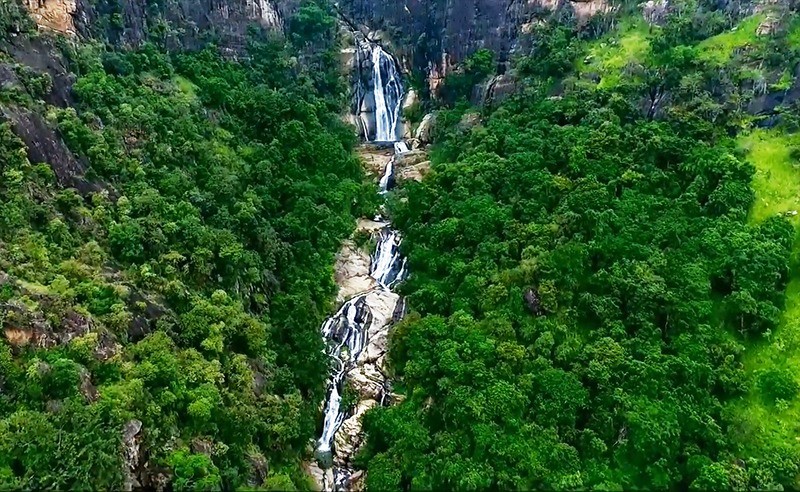Sri Lanka’s mountains are home to Nuwara Eliya. This is the ideal place for growing tea because of its high elevation and fresh temperature. Large tea plantations and tea houses can be found here. It is imperative to discover and gain additional knowledge about the tea-making process while visiting Nuwara Eliya. A visit to one of these tea estates is the ideal method to accomplish this. I’ll share more about our trip to Sri Lanka’s tea farms in this blog post, along with some advice on taking a tea tour!
Plantations of tea in Nuwara Eliya
As we get inside the tuk-tuk, it starts to rain. Today, our driver drives us to two distinct tea estates. The first is located roughly 30 kilometers from Nuwara Eliya. As you drive across the undulating terrain, the rain ceases and a tiny bit of sunlight appears. The tea fields remind me a little bit of the French champagne area. The name of the plantation in question is indicated in large characters. The majority of the houses have traditional Scottish or British names.
Take a tour of the Tea Bush teahouse
The tea shop, Tea Bush, is where we start our tour. Here, our tour guide, Hansi, a happy woman from Sri Lanka, takes us on a tour of the factory. We get to watch the tea-making process in action as the green tea leaves go through a number of processes like rolling, fermenting, oxidizing, drying again, sorting, and bulk packing before becoming drinkable tea. Tea Bush tea is a “white label” beverage that isn’t sold in stores or supermarkets under its own brand. Every tea is sent in big bags to an auction house in London or Colombo, where it is bought by tea shops that resell it under different brands, like supermarkets.
Did you know that a young Scot named James Taylor brought tea to Sri Lanka in 1867? During that period, the majority of plantations grew coffee. Tea replaced coffee as the favored crop after the fungus killed the coffee trees.
It’s a little-known fact that expert tea tasters always sample the tea.
It’s time for tasting after the fascinating tour. We sample nine various teas, such as English breakfast tea, golden tea, and silver tea. My favorite tea is golden tea, which is derived from a different plant than black or green tea. Comparatively speaking, it is milder and sweeter than black tea. Ries and I stroll to the tasting room’s balcony as the tea is being cleared. We are in for a breathtaking vista of the Ramboda waterfalls. Additionally, we can see a building with a similar view close to the plant.
Ramboda Waterfall
Our driver asks us whether we would want to see the Ramboda waterfall when we get back in the tuk-tuk. We don’t refuse that, though. And thus, after a short while, we find ourselves at the base of a stunning waterfall that rises more than 100 meters. There are numerous waterfalls in Sri Lanka, some of which are much more exquisite than the others. Without a doubt, this is worthwhile.
Adma Argo, a strawberry farmer
Adma Argo’s strawberry farm is a quick visit, but one that I wholeheartedly endorse to everyone. This is a popular strawberry farm in Sri Lanka, and it’s where you can get a wide variety of strawberry-based items. We go with strawberry juice, and, to be honest, we’ve never tasted a better beverage! Really well advised! Pancakes, jam, and strawberry sweets are also available here.
Last stop: tea plantations
The tea factory is our final destination. You may stroll among the tea fields around the tea factory, which is a lovely feature. so that you can get a close-up look at the tea leaves. The tea plantation is huge, bustling with people, and has a decidedly commercial appearance. However, you can also sample some tea and take a free tour here. We returned to our hotel at half past one in the afternoon, having enjoyed a delightful morning!
Useful details about the visit to the tea estates.
This is a popular activity rather than an official tour of the tea farms in Nuwara Eliya. We recently inquired at the Landford Bungalow, where we are staying, about the possibility of setting up a tuk-tuk to transport us to some tea estates. And that’s scheduled right away. The tuk-tuk driver was paid Rs 2000. Like the tea tastings, tea estates are free to visit. There is also no charge for the waterfall. We drove for three and a half hours in total. Of course, you could accomplish this on your own with a scooter, but be aware of the rain. Here in the Highlands, the weather is changing quickly.
Useful information on a trip to Nuwara Eliya
Located in the center of Sri Lanka, in the hill country of Sri Lanka, is Nuwara Eliya. Compared to the rest of Sri Lanka, the city is significantly distinct. established by the English as a hunting vacation destination for their settlers. This still has a strong English flavor. There are gorgeous golf courses, a historic post office, and homes that look as though they were taken directly out of London.
What is the length of your stay in Nuwara Eliya?
It will only take you two days to see Nuwara Eliya if your main reason for going is to see the tea plantations. You will need extra time, though, if you also wish to explore the Horton Plains from Nuwara Eliya (to climb the summit of World’s End) or go on a (nocturnal) trip to Adam’s Peak. If so, I suggest staying for three or four nights.
Where in Nuwara Eliya do you sleep?
Many excellent hotels, largely in the English style, can be found in Nuwara Eliya. Even though the prices are normally a little higher than they are in Sri Lanka, they are still reasonable. The more opulent hotels and lovely guesthouses under budget that we can suggest are listed below.

